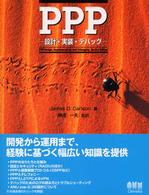Full Description
This book undertakes the first comparative constitutional analysis of the Kyrgyz Republic and Republics of Kazakhstan, Turkmenistan, Uzbekistan and Tajikistan in their cultural, historical, political, economic and social context.
The first chapter provides a general overview of the diverse and dynamic constitutional landscape across the region. A second chapter examines the Soviet constitutional system in depth as the womb of the Central Asian States. A third chapter completes the general picture by examining the constitutional influences of the 'new world order' of globalisation, neoliberalism, and good governance into which the five states were thrust. The remaining five chapters look in turn at the constitutional context of presidents and governments, parliaments and elections, courts and rights, society and economy and culture and identity.
The enquiry probes the regional patterns of neo-Sovietism, plebiscitary elections, weak courts and parliaments, crony capitalism, and constraints on association, as well as the counter-tendencies that strengthen democracy, rights protection and pluralism. It reveals the Central Asian experience to be emblematic of the principal issues and tensions facing contemporary constitutional systems everywhere.
Contents
INTRODUCTION
First Principles: Constitutional Orders, Constitutional Functions, Constitutional Processes
Methodology and Schools of Thought
Plan of the Work
Further Reading
1. CONSTITUTIONAL OVERVIEW: LIE OF THE 'STANS
Uzbekistan
Turkmenistan
Kazakhstan
Tajikistan
Kyrgyzstan
Further Reading
2. RED ORIGINS: DOING JUSTICE TO SOVIET CONSTITUTIONALISM
Soviet Constitutional Order
Soviet Authority (CPSU)
Soviet Federalism and Nationalities Regulation
Soviet Government
Soviet Planning and Ownership
Soviet Social Regulation and Protection
Soviet Rights Protection
Soviet Ideology
Soviet Local Variation
Constitutional Order and the Constitution
Soviet Constitutional Problems and Solutions
Further Reading
3. NATAL CHART: CONSTITUENT INFLUENCES AND PROCESSES
The Post-Soviet Moment and the Exigency of Sovereignty
The Constituent Process and the Texts Themselves
Property, The Market and Welfare
Culture and Constitution
Transition Tutelage: Good Governance, Rule of Law, Democratisation
Conclusion
Further Reading
4. SUPER-PRESIDENTS AND SUPERPOWERS
Imbalance of Power
Presidential Particulars: Presidency and President
Presidential Power: Government and its Subordinate Agencies; Local Administration
Presidential Power: Parliament
Presidential Power: Judicial Structures
Presidential Power: Elections/Referenda
Presidential Power: Administration/Apparat and Directly Subordinate Agencies
Presidential Power: National Security
Presidential Power: Lawmaking
Immunity and Impeachment
Doing Justice to Super-presidentialism
Further Reading
5. TALKING SHOP OR GOVERNING BODY: PARLIAMENT
Parliamentary Basics: Composition, Parliamentarians and Parties Parliament as Institution: Structure, Leadership, Development
Parliamentary Powers: Lawmaking
Other Parliamentary Powers
The Meta-rules of Representation
Elections and Term of Office
A Tale of Two Parliaments, and Two Constitutions:
Tajik and Kyrgyz
Further Reading
6. HONOUR IN THE BREACH: RIGHTS, COURTS AND JUSTICE
Constitutional Role and Functions of the Central Asian Judiciaries
Constitutional Evolution of the Central Asian Judiciaries
Governance: Judicial Personnel Management and Court Administration
Structure and Functions: The Five Court Systems
Constitutional Basis of the Central Asian Justice System: Internal Affairs, Justice and the Procuracy
Rights and Remedies
Judicial Protection
International Protection
Supplementary Protection: Procuracy and Human Rights Institutions
Further Reading
7. PLAN TO CLAN: TRANSITIONS, ECONOMIC AND SOCIAL
Constitutional Regulation of the Economy: Basic Rules
Constitutional Regulation of the Economy: Basic Institutions
Economic Constitutionalism: Foreign Investment and International Integration
The 'Material Constitution': Crony Capitalism, Corruption, Crime
Social Provision and Protections (Pensions, Unemployment, Poverty, Gender)
Further Reading
8. CENTRAL ASIA CONSTITUTIONS AND CENTRAL ASIAN DIFFERENCE: THE REGULATION OF PLURALISM
Identity: Who, the People?
Citizenship and Ethnicity ('Nationality')
Federalism, Devolution
Language
Culture
Religion
Local and Regional Government
Further Reading








